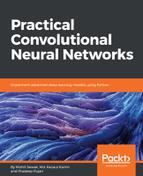Fast R-CNN, or Fast Region-based CNN method, is an improvement over the previously covered R-CNN. To be precise about the improvement statistics, as compared to R-CNN, it is:
- 9x faster in training
- 213x faster at scoring/servicing/testing (0.3s per image processing), ignoring the time spent on region proposals
- Has higher mAP of 66% on the PASCAL VOC 2012 dataset
Where R-CNN uses a smaller (five-layer) CNN, Fast R-CNN uses the deeper VGG16 network, which accounts for its improved accuracy. Also, R-CNN is slow because it performs a ConvNet forward pass for each object proposal without sharing computation:

In Fast R-CNN, the deep VGG16 CNN provides essential computations for all the stages, namely:
- Region of Interest (RoI) computation
- Classification Objects (or background) for the region contents
- Regression for enhancing the bounding box
The input to the CNN, in this case, is not raw (candidate) regions from the image, but the (complete) actual image itself; the output is not the last flattened layer but the convolution (map) layer before that. From the so-generated convolution map, a the RoI pooling layer (a variant of max-pooling) is used to generate the flattened fixed-length RoI corresponding to each object proposal are generated, which are then passed through some fully connected (FC) layers.
The output from the penultimate FC layer is then used for both:
- Classification (SoftMax layer) with as many classes as object proposals, +1 additional class for the background (none of the classes found in the region)
- Sets of regressors that produce the four numbers (two numbers denoting the x, y coordinates of the upper-left corner for the box for that object, and the next two numbers corresponding to the height and width of that object found in that region) for each object-proposal that is required to make bounding boxes precise for that particular object
The result achieved with Fast R-CNN is great. What is even greater is the use of a powerful CNN network to provide very effective features for all three challenges that we need to overcome. But there are still some drawbacks, and there is scope for further improvements as we will understand in our next section on Faster R-CNN.
